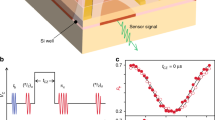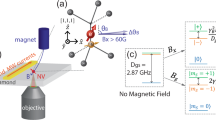Abstract
Quantum sensors based on single solid-state spins promise a unique combination of sensitivity and spatial resolution1,2,3,4,5,6,7,8,9,10,11,12,13,14,15,16,17,18,19,20. The key challenge in sensing is to achieve minimum estimation uncertainty within a given time and with high dynamic range. Adaptive strategies have been proposed to achieve optimal performance, but their implementation in solid-state systems has been hindered by the demanding experimental requirements. Here, we realize adaptive d.c. sensing by combining single-shot readout of an electron spin in diamond with fast feedback. By adapting the spin readout basis in real time based on previous outcomes, we demonstrate a sensitivity in Ramsey interferometry surpassing the standard measurement limit. Furthermore, we find by simulations and experiments that adaptive protocols offer a distinctive advantage over the best known non-adaptive protocols when overhead and limited estimation time are taken into account. Using an optimized adaptive protocol we achieve a magnetic field sensitivity of 6.1 ± 1.7 nT Hz−1/2 over a wide range of 1.78 mT. These results open up a new class of experiments for solid-state sensors in which real-time knowledge of the measurement history is exploited to obtain optimal performance.
This is a preview of subscription content, access via your institution
Access options
Subscribe to this journal
Receive 12 print issues and online access
$259.00 per year
only $21.58 per issue
Buy this article
- Purchase on Springer Link
- Instant access to full article PDF
Prices may be subject to local taxes which are calculated during checkout




Similar content being viewed by others
References
Giovannetti, V., Lloyd, S. & Maccone, L. Advances in quantum metrology. Nature Photon. 5, 222–229 (2011).
Higgins, B. L. et al. Entanglement-free Heisenberg-limited phase estimation. Nature 450, 393–396 (2007).
Degen, C. L. Scanning magnetic field microscope with a diamond single-spin sensor. Appl. Phys. Lett. 92, 243111 (2008).
Taylor, J. M. et al. High-sensitivity diamond magnetometer with nanoscale resolution. Nature Phys. 4, 810–816 (2008).
Maze, J. R. et al. Nanoscale magnetic sensing with an individual electronic spin in diamond. Nature 455, 644–647 (2008).
Balasubramanian, G. et al. Nanoscale imaging magnetometry with diamond spins under ambient conditions. Nature 455, 648–451 (2008).
Balasubramanian, G. et al. Ultralong spin coherence time in isotopically engineered diamond. Nature Mater. 8, 383–387 (2009).
Dolde, F. et al. Electric-field sensing using single diamond spins. Nature Phys. 7, 459–453 (2011).
Acosta, V. M. et al. Temperature dependence of the nitrogen-vacancy magnetic resonance in diamond. Phys. Rev. Lett. 104, 070801 (2010).
Toyli, D. M. et al. Fluorescence thermometry enhanced by the quantum coherence of single spins in diamond. Proc. Natl Acad. Sci. USA 110, 8417–8521 (2013).
Ovartchaiyapong, P., Lee, K. W., Myers, B. A. & Bleszynski Jayich, A. C. Dynamic strain-mediated coupling of a single diamond spin to a mechanical resonator. Nature Commun. 5, 4429 (2014).
Le Sage, D. et al. Optical magnetic imaging of living cells. Nature 496, 486–489 (2013).
Kaufmann, S. et al. Detection of atomic spin labels in a lipid bilayer using a single-spin nanodiamond probe. Proc. Natl Acad. Sci. USA 110, 10894–10898 (2013).
Kucsko, G. et al. Nanometre-scale thermometry in a living cell. Nature 500, 54–58 (2013).
Shi, F. et al. Single-protein spin resonance spectroscopy under ambient conditions. Science 347, 1135–1138 (2015).
Maletinsky, P. et al. A robust scanning diamond sensor for nanoscale imaging with single nitrogen-vacancy centres. Nature Nanotech. 7, 320–324 (2011).
Staudacher, T. et al. Nuclear magnetic resonance spectroscopy on a (5-nanometer)3 sample volume. Science 339, 561–563 (2013).
Mamin, H. J. et al. Nanoscale nuclear magnetic resonance with a nitrogen-vacancy spin sensor. Science 339, 557–560 (2013).
Tetienne, J.-P. et al. Nanoscale imaging and control of domain-wall hopping with a nitrogen-vacancy center microscope. Science 344, 1366–1369 (2014).
Kolkowitz, S. et al. Probing Johnson noise and ballistic transport in normal metals with a single-spin qubit. Science 347, 1129–1132 (2015).
Said, R. S., Berry, D. W. & Twamley, J. Nanoscale magnetometry using a single-spin system in diamond. Phys. Rev. B 83, 125410 (2011).
Waldherr, G. et al. High-dynamic-range magnetometry with a single nuclear spin in diamond. Nature Nanotech. 7, 105–108 (2012).
Nusran, N. M. et al. High-dynamic-range magnetometry with a single electronic spin in diamond. Nature Nanotech. 7, 109–112 (2012).
Vijay, R. et al. Stabilizing Rabi oscillations in a superconducting qubit using quantum feedback. Nature 490, 77–80 (2012).
Blok, M. S. et al. Manipulating a qubit through the backaction of sequential partial measurements and real-time feedback. Nature Phys. 10, 189–193 (2014).
Shulman, M. D. et al. Suppressing qubit dephasing using real-time Hamiltonian estimation. Nature Commun. 5, 5156 (2014).
Robledo, L. et al. High-fidelity projective read-out of a solid-state spin quantum register. Nature 477, 574–578 (2011).
Cappellaro, P. Spin-bath narrowing with adaptive parameter estimation. Phys. Rev. A 85, 030301 (2012).
Higgins, B. L. et al. Demonstrating Heisenberg-limited unambiguous phase estimation without adaptive measurements. New J. Phys. 11, 073023 (2009).
Hentschel, A. & Sanders, B. C. Machine learning for precise quantum measurement. Phys. Rev. Lett. 104, 063603 (2010).
Hayes, J. F. A. & Berry, D. W. Swarm optimization for adaptive phase measurements with low visibility. Phys. Rev. A 89, 013838 (2014).
Berry, D. W. & Wiseman, H. M. Optimal states and almost optimal adaptive measurements for quantum interferometry. Phys. Rev. Lett. 85, 5098–5101 (2000).
Acknowledgements
The authors thank M. Tiggelman and R. Schouten for the development of the FPGA. The authors acknowledge support from the Dutch Organization for Fundamental Research on Matter (FOM), the Netherlands Organization for Scientific Research (NWO), the DARPA QuASAR programme, the EU SOLID and DIAMANT programmes and the European Research Council through a starting grant. D.W.B. is funded by an Australian Research Council Future Fellowship (FT100100761).
Author information
Authors and Affiliations
Contributions
C.B., M.S.B. and R.H. conceived the experiments. C.B. and M.S.B. performed the measurements and numerical simulations and processed the data. H.T.D. and D.W.B. calculated the incremental phases for the optimized adaptive protocol and provided general theoretical support. M.L.M. and D.J.T. designed and carried out the synthesis of isotopically enriched diamond material. C.B., M.S.B. and R.H. wrote the manuscript. All authors analysed the results and commented on the manuscript.
Corresponding author
Ethics declarations
Competing interests
The authors declare no competing financial interests.
Supplementary information
Supplementary information
Supplementary information (PDF 1174 kb)
Rights and permissions
About this article
Cite this article
Bonato, C., Blok, M., Dinani, H. et al. Optimized quantum sensing with a single electron spin using real-time adaptive measurements. Nature Nanotech 11, 247–252 (2016). https://doi.org/10.1038/nnano.2015.261
Received:
Accepted:
Published:
Issue Date:
DOI: https://doi.org/10.1038/nnano.2015.261
This article is cited by
-
Learning quantum systems
Nature Reviews Physics (2023)
-
Integrable quantum many-body sensors for AC field sensing
Scientific Reports (2022)
-
Ultra-high dynamic range quantum measurement retaining its sensitivity
Nature Communications (2021)
-
Quantum guidelines for solid-state spin defects
Nature Reviews Materials (2021)
-
Online adaptive quantum characterization of a nuclear spin
npj Quantum Information (2021)



